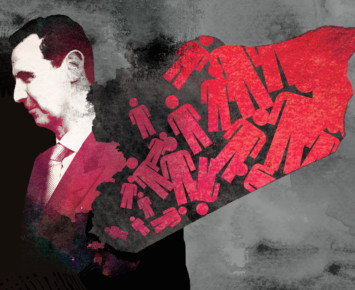
After seven long years of bloody war, Syria has become simply the land of victims. Why is the world allowing this to happen? It is becoming increasingly clear by the day that both the Geneva process and the Astana format for a settlement in Syria are seriously under threat of being made redundant, ironically by the same people who helped craft them — Russia and the United States.
Instead of maintaining the peace initiated by Staffan de Mistura, the United Nations Syria envoy, Moscow and Washington — with the approval of the UN Security Council — have opted to follow the piecemeal method, supposedly in search of a solution.
In Damascus, President Bashar Al Assad has never felt more comfortably secure during the course of this brutal war than he is now. Appearing confident in May, Al Assad claimed the peace talks orchestrated by the UN’s Syria envoy were becoming “irrelevant”. With the direct military and political protection by Russia, Iran and Lebanese militia, Hezbollah, Al Assad went further to say that he was only interested in the plans for ‘de-escalation zones’ set out by Russia, Iran, Turkey and (the recently joined) US, in the Kazakh capital, Astana.
You can’t blame Al Assad for feeling confident as leading powers and the world’s most influential decision-makers seem to be turning to accepting the notion that they can live, even though temporarily, with the butcher of Syria. Even France, once at the forefront of countries calling for regime change in Damascus, is now, under its new President Emanuel Macron, bizarrely entertaining the idea of considering Al Assad as a part of the solution.
Unfortunately for Syria and Syrians, this ugly war has been allowed to blindly continue without any clear aims nor determined set of principles. For almost seven bloody years, it has failed to produce eventual results nor victors. It has presented the world, so far, with only victims.
Almost half of the population have either been killed or become refugees. An estimated 400,000 Syrians have lost their lives, more than five million are refugees in neighbouring countries with some asylum seekers in Europe, while another five million are displaced people in their own country. The United Nations estimates that an entire generation of Syrian children has been deprived, in varying degrees, of access to education.
This is all happening under our gaze and many find this difficult to comprehend at a time when the entire Syrian society is, day after day, constantly torn apart.
With this total misery of unstoppable action in mind, the current piecemeal process undertaken by some regional and international powers will not succeed in bringing the shattered structure of Syria back to its normal self. This is extremely unlikely unless a miracle happens. With the rarity of miracles and the absence of a potential victor, or victors, the vast majority of Syrians, including those living in areas under the regime’s control, will sadly continue to pay a heavy price in human lives as well as in kind.
The continuous upheaval in Syria has already made its ramifications felt across Europe. Neighbouring Turkey, sitting at the doorstep of the European Union, is heavily involved in Syria’s intractable conflict. Turkish troops move freely deep inside northern Syria where Turkey’s President, Recep Tayyip Erdogan, is fighting a war against Kurdish rebels led and organised by the Kurdistan Workers Party (PKK).
The rise of the Syrian Kurdish fighters, supported by the US administration, and talk about giving them the right of self-control authority over an enclave in northern Syria, are strategically worrying developments for Erdogan. The Turkish president is keen to ensure that such authority will not benefit the PKK, whose insurgents are located not only in eastern and south-eastern Turkey, but also spill over into both northern Iraq and Syria.
Additionally, the failed coup in July 2016 and the thoroughly constitutional changes he had already made earlier in the year in turning Turkey’s government into a centrally controlled presidential system, resulted in Erdogan gaining total control of the country. Erdogan has his own agenda in Syria, which has nothing to do with what sort of government would or should exist in Damascus. His main concern is clearly the demographic and political make-up in Syria’s north.
Similarly, some tripartite arrangement is being made for south-west Syria — one in which Russia, the US and Jordan have been involved in. A ceasefire agreement declared by US Secretary of State Rex Tillerson during the G20 summit and implemented on July 9, is apparently the result of months of behind-the-scenes negotiations among the three parties.
These negotiations started at the beginning of Donald Trump’s administration and apparently had the support of both the Al Assad regime and the main rebel group in the area. An American source, who requested anonymity, told this writer that Israel had been fully briefed before and during the negotiations because of the proximity of the occupied Golan Heights to the south-western part of Syria.
Such developments mark the first major step in US-Russian cooperation in Syria. Tillerson bluntly stated that both his country and Russia have the same goals and the ceasefire agreement was the first indication of the US and Russia “being able to work together in Syria”.
But the question remains whether these piecemeal tactics will put an end to this continuous, atrocious war.
— Mustapha Karkouti is a former president of the Foreign Press Association, London. You can follow him on Twitter at @mustaphatache.









